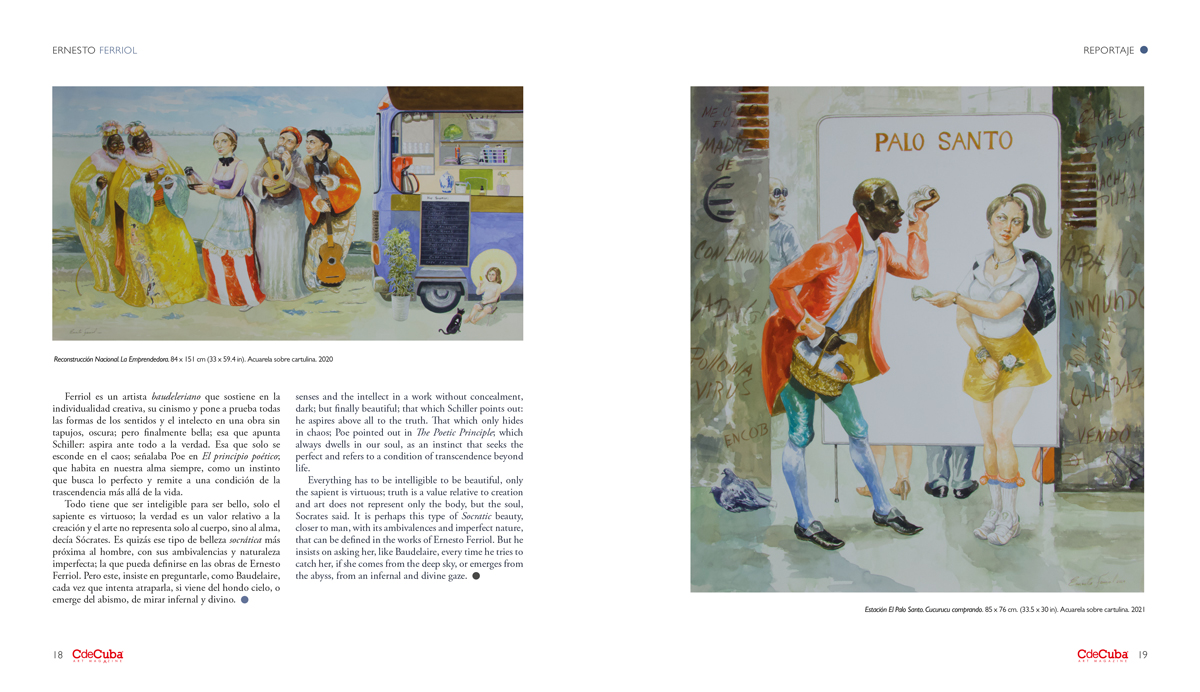Between the Visible and Disappearance
Por Liannys Lisset Peña Rodríguez
María Zambrano once said that drawing belongs to the rarest species of things, that it is a genre of being on the verge of non-being. Perhaps that is why Ernesto Ferriol chooses it as a method, a logbook, to write down his involuntary raptus; to insist restlessly on the past, as a cognitive act on the present; and to speak of all memories, in a context where forgetfulness has become common; or because it is the only way to enter into what Fernando Castro Flórez calls the nebulous terrain of memory.1
This artist once confessed to me; that without drawing he cannot break down that information of the real that interests him; that he tears a piece of paper and draws to get a glimpse of it, to have it, without trapping it (…) like those splinters of the world, that come and go, and do not last long; they begin to disappear as soon as they appear.2
Ferriol constructs his scenes as a poetic whole, about chaotic life and its helpless inhabitants. The erotic is nothing more than a ruse. Always in the pretense of sowing doubt. What can discover the logic of what is seen in the space of desire, flesh or sex; is nothing more than the purpose of narrating from the experience of the real. For all symbolic representation is based on “patterns of truth,” Joel Snyder argues. With them the artist reinforces his stories and transforms them into visual fictions; from powerful images (shunga) and at the same time fragile (ukiyo-e). Like that unique way that each one of us has to fabulate from what we have lived. These complex structures end up in watercolor, as a genre that has been appropriated, in that cultural amalgam with which it coexists.
It is in the equivalence of thinking and drawing where the body becomes a reality in constant conflict. The nude is only appearance. The insistence on the erotic is a call to the prevalence of the image in the retinas. The orgies; the carnivalesque, or absurd, are aimed at voyeurism; the gaze of the other; that chaos of the morbid, irremediable and even undeserved; typical of an aesthetic close to dirty realism.
Dual nature; in which the contrast between the Dionysian sensibility and the Apollonian notion of incessant search for the perfect form is sensed. According to Nietzsche both manage to embrace the depth of human existence and also embrace the irrational and impossible, which cannot be expressed through words. The artist stimulates the instincts, the desire; in the simple look of the characters towards the one who observes; as an invitation, questioning, and even challenge; to look for everything that has been veiled and is not in plain sight.
Real, morbid, black stories. Tragic substitution of life for an unspecified truth, which is sustained by the idea that appears after being contemplated many times. Their intentions are above all interpretative. They are images that possess, and at the same time suspend, as Walter Benjamin said. Because our own existence, in its becoming, clings to this suspension. They are symbolic-rhetorical surfaces that host stark, erotic scenes; but paradoxically the pleasure they can generate, is transformed into bitter truths to the intellect and thought.
A clearly Nietzschean work, of oppositions and balances: as shadows need light. The sinister image is perfect: what could be more perverse and at the same time harmonious than a woman’s body? Here we see the Venusian, in the preponderance of the feminine as an element that produces both joy and unhappiness. But, even so, it is necessary to stop, contemplate and even stay in that double edge of beauty, which, from the Dionysian, persists in reaching the sublime experience.
Ferriol is a Baudelairean artist who sustains in creative individuality, his cynicism and tests all the forms of the senses and the intellect in a work without concealment, dark; but finally beautiful; that which Schiller points out: he aspires above all to the truth. That which only hides in chaos; Poe pointed out in The Poetic Principle; which always dwells in our soul, as an instinct that seeks the perfect and refers to a condition of transcendence beyond life.
Everything has to be intelligible to be beautiful, only the sapient is virtuous; truth is a value relative to creation and art does not represent only the body, but the soul, Socrates said. It is perhaps this type of Socratic beauty, closer to man, with its ambivalences and imperfect nature, that can be defined in the works of Ernesto Ferriol. But he insists on asking her, like Baudelaire, every time he tries to catch her, if she comes from the deep sky, or emerges from the abyss, from an infernal and divine gaze.
1 Castro Flórez, Fernando: El don (amoroso) de la memoria (demorada). Considerations on the draftsmanship of Concha Martínez. Text taken from the artist’s website.
2 Didi-Huberman, Georges: Vislumbres. Editorial Shangrila. September 2019 p.23






